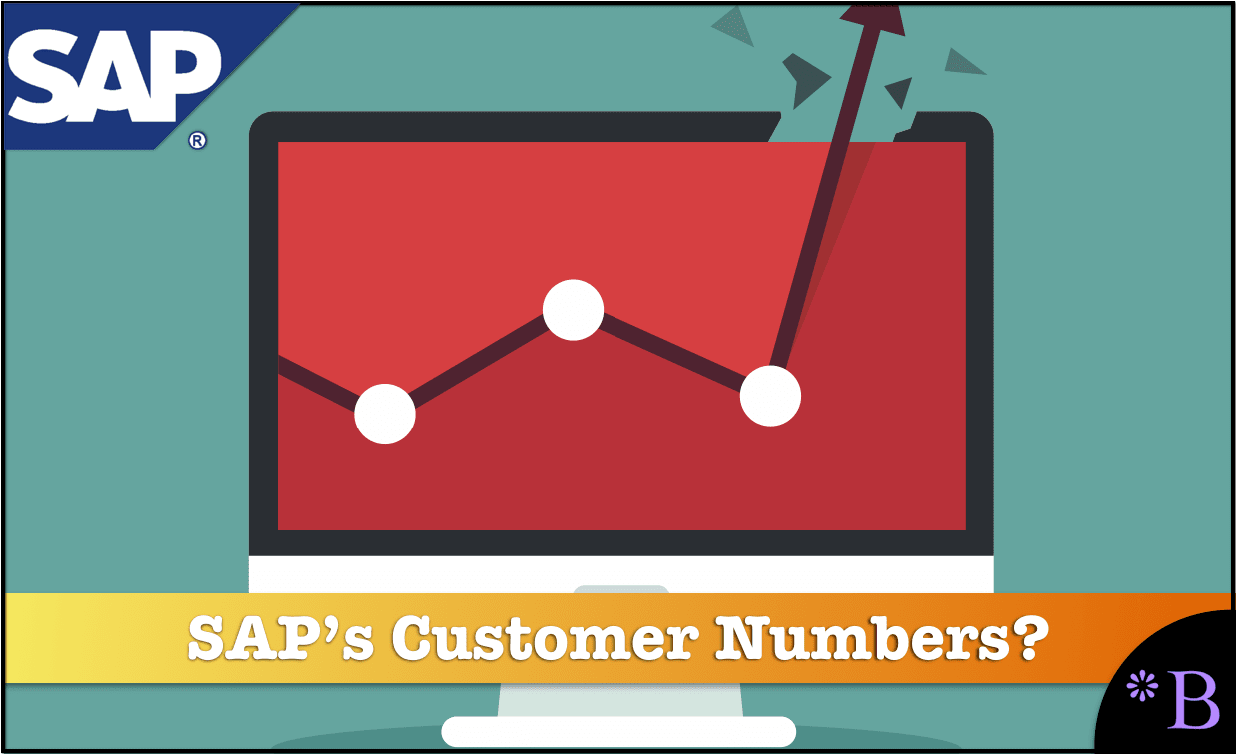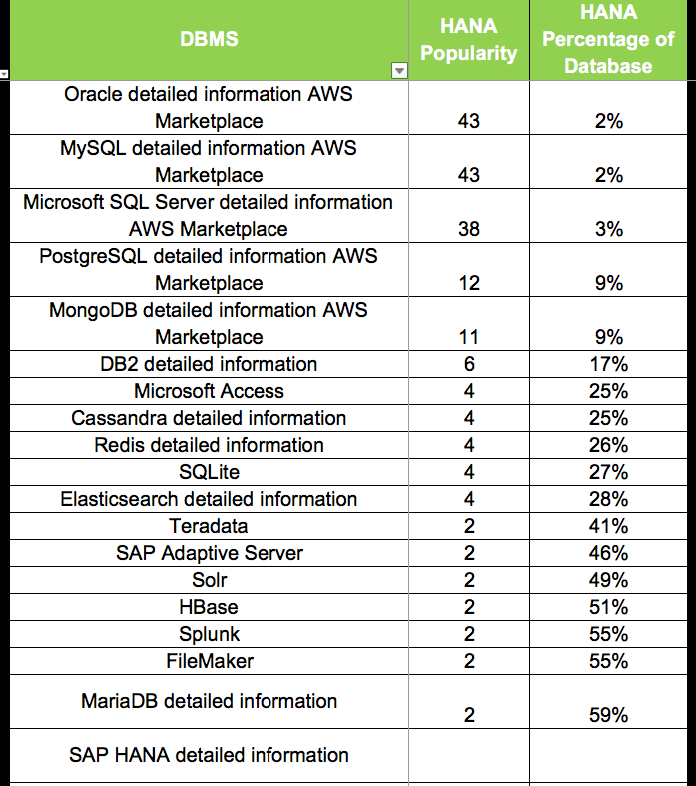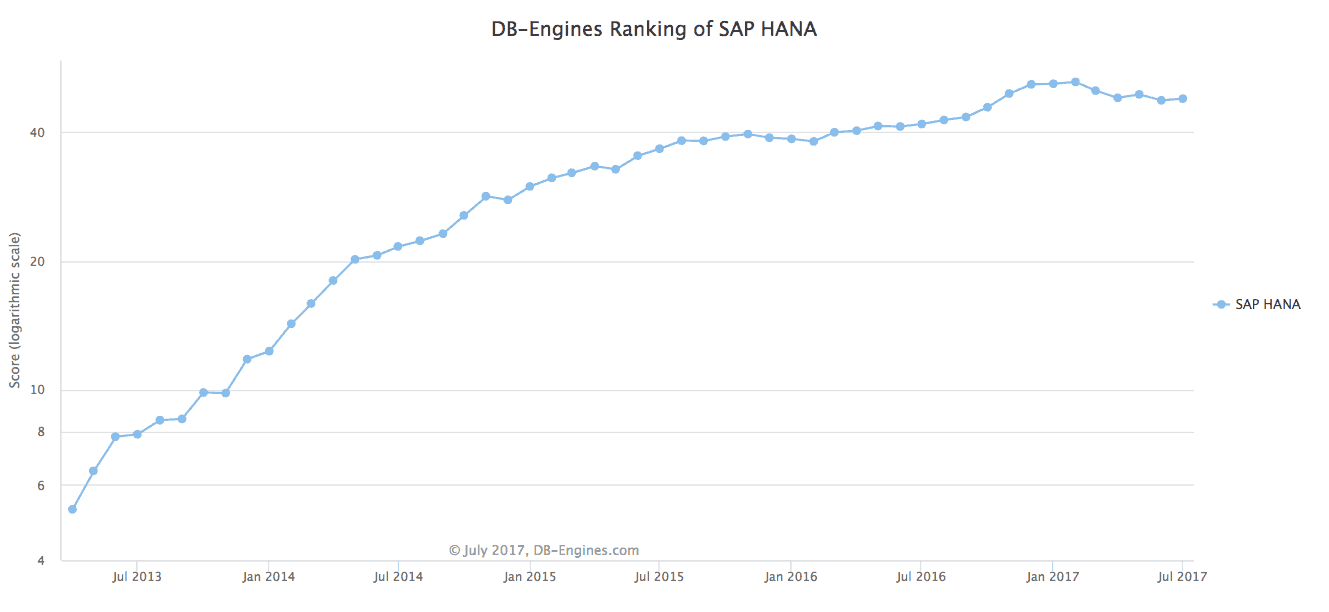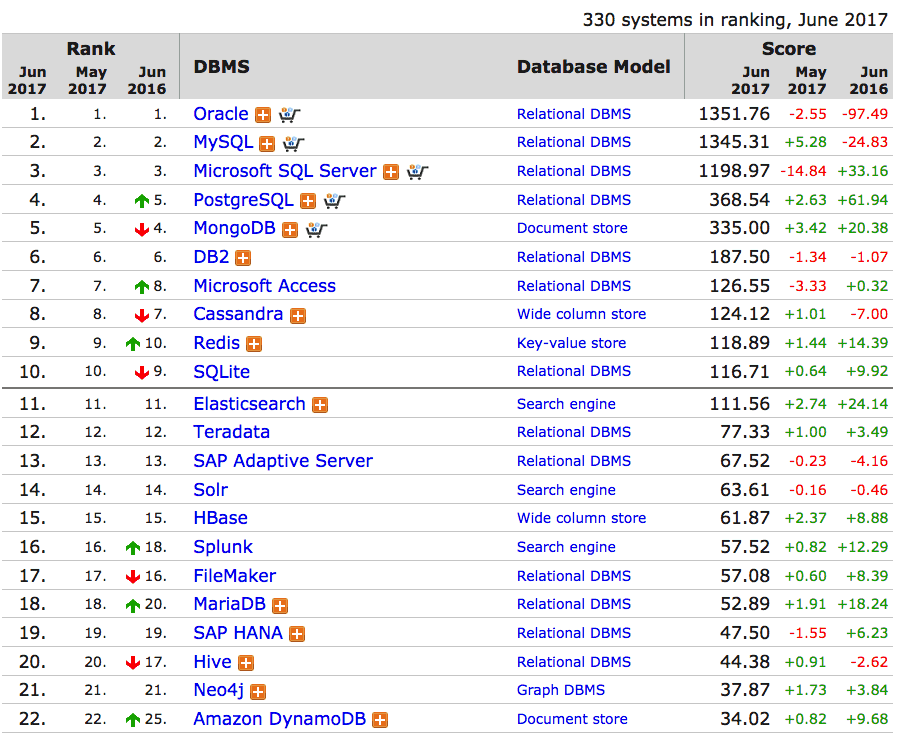How Popular is SAP HANA in Reality?
Executive Summary
- SAP has created misleading impressions regarding HANA’s growth.
- We fact-checked SAP by using the independent DB-Engines ranking.

Video Introduction: Fact Checking HANA’s Growth
Text Introduction (Skip if You Watched the Video)
SAP has been proposing that HANA is the fast growing database of all time. Part of this puffery is simply designed to help SAP sell more HANA licenses and has no connection to reality. SAP also makes claims for the use of HANA with applications that do not make much sense. What is the truth about HANA’s usage? You will learn about our unbiased analysis of the reporting of a site that tracks database usage and as we review SAP’s claims around HANA’s growth.
Our References for This Article
If you want to see our references for this article and other related Brightwork articles, see this link.
Notice of Lack of Financial Bias: We have no financial ties to SAP or any other entity mentioned in this article.
Statements About HANA’s Growth
SAP and their surrogates have made some seriously buoyant statements regarding HANA’s growth. Back in 2013, Peter Goldmacher of Cowen and Co-accused SAP of inflating the HANA growth figures.
“SAP executives have not only called HANA the fastest-growing product in the history of SAP, co-CEO Bill McDermott said it was “the fastest growing software product in the history of the world.”
Peter Goldmacher had the following to say about HANA and Bill McDermott’s statement:
“If we take management at its word and believe that HANA’s two-year license growth [rate] through FY13 is about 120 percent, then this means that the other 90 percent of SAP’s license business, Apps and BI, is growing at … roughly 2 percent, materially below category growth rates … Our research and experience lead us to believe that SAP is allocating product revenue subjectively and that this is resulting in an inflated HANA growth rate.”
SAP did not like this interpretation, and SAP spokesperson Jim Dever fired back at Goldmacher.
“Roughly half of HANA business is stand-alone deals, HANA and nothing else. We think his report could not be more inaccurate in its assumptions,” he told Business Insider. “We have been consistent in our HANA pricing, our no-discount policy, and our reporting of growth rates and revenue results – and have no changes to announce.” – Business Insider
And it was not only SAP that came forward with bold claims regarding HANA growth but also its surrogates. For instance, John Appleby of Bluefin Solutions said the following in his article 2013, the Year of the SAP Database.
“We’ve heard a lot about the SAP HANA database platform over the last 18 months since its release, and whilst we are in the quiet period between end of year and SAP releasing earnings reports in mid-January, the investors I talk to are talking about bookings between €350m and €400m for the year (as compared to €160m in the first full year, 2011), which probably makes SAP HANA the fastest growing database of all time, if not the fastest growing enterprise software product – ever.(emphasis added)”
Is it just me, or does this quote from John Appleby appears to be a copy of what was stated by Bill McDermott?
Secondly, it undeniably sounds definitive, as any sentence that is ended with “- ever” tends to be.
SAP also made these claims in the PR release — SAP’s HANA Bet Seems to be Paying Off.
A Big Promise Begins to Pay Off?
During his Sapphire World keynote in 2013, SAP CEO Bill McDermott told an audience of more than 100,000 in person and online listeners that the company was betting the farm on the new database.
“Let’s be clear on HANA,” he said. “HANA not only represents the intellectual renewal of SAP (SAP was founded in 1972), it is now the platform for every single thing the SAP company will do going forward.”
When you consider that more than 293,500 companies use SAP to run their businesses, and that only a fraction of them use HANA, it was, and still is, a big bet.
But it’s beginning to pay dividends.
Marie Goodell, head of HANA platform marketing at SAP told CMSWire that HANA’s momentum continues to build and that it keeps finding new heights. In fact, it has become the fastest growing product in SAP’s 43 year history.
HANA is not the platform for every single thing moving forward. Years after this quotation, SAP is finally reducing its emphasis on HANA. For example, SuccessFactors and Ariba are not moving to HANA. Most of SAP’s applications will continue to use non-SAP databases.
Marie Goodell is incorrect. If HANA were the fastest growing product in SAP’s 43-year history, it would exceed SAP’s R/3 system, which was, in fact, the fastest growing SAP application ever. Also, if HANA was so fast growing, why four years after that statement is HANA still only the 19th most popular database globally, and why does it only have a 6.14% growth rate? Understanding the DB-Engines Ranking
DB-Engines Ranking is a site that uses a method that combines a series of factors to result in a rank of how widely a particular database is used. So what factors do they use? Well, I have listed their description of their method below:
“Number of mentions of the system on websites, measured as number of results in search engines queries. At the moment, we use Google, Bing and Yandex for this measurement. In order to count only relevant results, we are searching for <system name> together with the term database, e.g. “Oracle” and “database”.
General interest in the system. For this measurement, we use the frequency of searches in Google Trends.
Frequency of technical discussions about the system. We use the number of related questions and the number of interested users on the well-known IT-related Q&A sites Stack Overflow and DBA Stack Exchange.
Number of job offers, in which the system is mentioned. We use the number of offers on the leading job search engines Indeed and Simply Hired.
Number of profiles in professional networks, in which the system is mentioned. We use the internationally most popular professional networks LinkedIn and Upwork.
Relevance in social networks. We count the number of Twitter tweets, in which the system is mentioned.” – DB-Engines
This seems like a reasonable way to perform a ranking. However, when it comes to HANA, this method will tend to exaggerate HANA’s usage. This is because of the following inputs.
- Number of Mentions on Websites: This will exaggerate HANA’s actual usage because SAP has spent big money to promote HANA. Big consulting companies promote all SAP products, not because the applications are useful, but because SAP implementations provide the most billing hours and at the highest rate per hour of any vendor in enterprise software. Even Oracle’s consulting network is tiny compared to SAP’s.
- Google Trends: Google Trends is responsive to published material and searches. But many searches are driven by marketing. This will tend to exaggerate HANA’s usage.
- Number of Profiles in Professional Networks: Many people have placed HANA on their LinkedIn profiles because they want to be associated with a scarce and highly publicized product. Many people with this HANA terminology don’t know much about HANA. They can be solution architects, salespeople, etc.. This overestimates usage.
We will use this information further on in this article.
HANA Powering All SAP Products?
In an article titled SAP’s HANA Deployment Leapfrog’s Oracle, IBM and Microsoft published in Readwrite; the following quote reiterates this popularity.
HANA, was first made generally available as a standalone database in mid-2011, and SAP now claims to have almost 1,000 customers. The company believes those numbers can rise even faster once HANA powers all of its products.
It was 2019 when the article you read was updated eight years after HANA’s introduction and six years after the Readwrite article was published. HANA is still not even close to “powering all of SAP’s products.” HANA barely has very much penetration outside of the BW. It has also received pushback from groups inside SAP that do not want their applications ported to HANA.
Bad Uses for SAP HANA
SAP is feverishly pitching HANA for all types of inappropriate and wasteful uses. I am getting information about SAP CRM being placed on HANA. For what reason?
Let us stop to think. Who would put CRM on HANA?
HANA For CRM?
This is just about one of the silliest uses of HANA. CRM systems have very low requirements. Honestly, one can barely justify even using a CRM system versus a spreadsheet. Why would one need such fast read access for a CRM system?
HANA for Big Data?
So SAP has HANA to offer in the Big Data space, but HANA can’t possibly be a good use for Big Data because it is not for unstructured data, and it is quite expensive, and it is priced per GB or TB. This topic is covered in the article The Secret to Not Talking About HANA Pricing. SAP argues that HANA can be connected to Hadoop using Vora, but why would Hadoop need HANA? And is it a Big Data database if it just connects to a real Big Data database that does all the heavy lifting?
On G2Crowd, SAP is not even listed on Big Data processing ratings, in which Hadoop, Cloudera, HortonWorks, and DataBricks are the top rated.
HANA for the Enterprise Data Warehouse?
None of this background has stopped SAP from proposing companies use HANA as the EDW. And when SAP recommends using HANA for the EDW, they also mean using an SAP data application to sit on top of HANA.
- Expense: The first problem is that HANA is still so expensive that it is not financially feasible in most cases to push so much data inside of it. HANA’s high TCO is not merely related to its license cost but to its hardware requirements, its high implementation and maintenance overhead, difficulty finding experienced skills, and its immaturity.
- 100% In Memory for an EDW?: Much of the data in an EDW does not require the performance capabilities of an in-memory database. In memory databases only make sense for supporting databases with a high query volume, not data stores used to feed the queried database.
- Migrating All Data to Column Oriented Tables for Storage?: Most data in companies is not stored in the column-oriented tables that are used in HANA. For this reason, moving data into a HANA “powered” Enterprise Data Warehouse would mean changing the data from its original storage structure into the HANA structures. This is an unnecessary and overcomplicated amount of work and overhead to maintain before one even gets to the question of what SAP product should be used. SAP BW is too high in overhead to be a useful EDW tool. And Business Objects has been so starved of development by SAP that it is no longer an application that companies should be considered for investment due to competitiveness and support issues. And once one eliminates these two data applications, there is nothing else that SAP offers that could fill this role to interoperate with HANA, even if HANA were a good choice for being the EDW database.
Calculating HANA’s Relative Popularity
To begin, let us review the usage/popularity list from DB-Engines.
HANA’s DB-Engines Ranking
According to DB-Engines, HANA is the 19th most popular database in the market.
But that tells us less than the relative popularity measured in gross terms of usage. For that, we need to perform a calculation with this data set.
To perform this calculation, we need to reduce HANA’s popularity score due to the overestimations that are part of DB-Engine’s calculation method.
Why am I doing this? Well, because DB-Engine is tracking something a bit different than I am looking for. I am trying to get to usage and am not interested in media mentions.
It wasn’t easy to know how much to reduce this value by, but I settled on a reduction in 1/3. I was tempted to do more than this, but whether it is a reduction of 1/3 or 1/2, it does not end up making that much of a difference.
Therefore, HANA’s 47.50 score was reduced to 31.35.
The next step was to divide the HANA score by each of the more popular databases’ scores. I did this on the table which is displayed below:

Observations and HANA’s Current Popularity and Growth
According to my calculations, HANA is only 2% as popular as Oracle and MySQL and 3% as popular as SQLServer.
This is not very popular, and four years after Bill McDermott’s and John Appleby’s statements, it would not be possible for HANA to have been the fastest-growing product in the history of software. The average growth rate of the databases ahead of HANA is 4.5%. So HANA is growing 1.73 percentage points faster than the average.
Now an SAP salesperson or consultant might say that HANA has only been out for around seven years and is still ramping up. However, the issue with that argument is the following:
- Transitioning from Easy to More Difficult Accounts: SAP could sell HANA into its most compliant accounts. As SAP moves away from those accounts, selling HANA becomes more difficult.
- HANA’s Exaggerations: SAP greatly exaggerated HANA’s benefits, as is covered in the article, When Articles that Exaggerate the Benefits of HANA. This is now becoming more apparent to customers who initially may have bought off on the marketing literature concepts.
- Enlarging HANA Beyond SAP BW: Most of HANA’s installs have been for the Business Warehouse (SAP’s Data Warehouse, aka the BW). HANA has been shown to improve the performance of SAP BW. But there is very little information available regarding the cost-benefit ratio to SAP BW on HANA. Once one gets beyond SAP BW, the value proposition for HANA becomes far weaker. This means SAP has already brought HANA to the easiest SAP application to make HANA fit. Growing HANA beyond the BW becomes more difficult.
Secondly, DB-Engines also shows HANA’s growth rate.
HANA’s Growth Chart
DB-Engines shows the following growth rate for HANA.

Here we can see that HANA picked up most of its popularity between April of 2013 and November of 2016. In these 39 months, HANA grew from 5.2 points to 39.15 points. That is a growth of 33.95 points. That translates to .87 points per month.
However, from November 2015 until July 2017, HANA has only picked up 8.79 points and grew an average of .43 points per month. In those 20 months, HANA only increased in popularity by 22%, and this is when SAP is showcasing HANA and placing major marketing muscle behind HANA.
Also, HANA has dipped since its peak in February 2017. HANA has declined since November of 2016.
HANA cannot be SAP’s flagpole marketing item forever. Eventually, HANA fatigue will (or already has) set it. If you are a competing group in HANA and see a chart similar to this, can’t you begin to question if SAP’s marketing resources are being used optimally? SAP can drive more revenues by switching the marketing emphasis to other products.
HANA as the Ace in the Hole?
Many SAP salespeople think their ace in the hole is that companies will have to migrate to HANA to migrate to S/4HANA. This is a forced migration, mind you. SAP can put any spin on it that it likes, but it is a coerced move to HANA, as presently no other database is certified to run on S/4HANA. There are also zero real technical reasons for making S/4HANA exclusive to HANA. I have analyzed every one of Hasso Plattner’s arguments on this topic through a great deal of time analyzing HANA. I have found all of the reasons provided by SAP for keeping S/4HANA exclusive to HANA to be inaccurate. Oracle 12c is a far more capable database than HANA, as I covered in What is the Actual Performance of HANA. Oracle is perfectly able to run S/4HANA, but SAP intends to block Oracle out of S/4HANA for commercial reasons. (and other databases may be capable as well, but I have not analyzed any other aside from Oracle 12c for supporting S/4HANA)
But that logic has a problem as well. S/4HANA has very low adoption. At some point, SAP may be forced to decide between promoting S/4HANA or promoting HANA, as its original plan of tying S/4HANA to HANA has so far not worked out as SAP intended. This is why I have proposed that SAP will eventually change its policy on the exclusivity of S/4HANA to HANA in the article SAP Will Backtrack on S/4HANA.
Conclusion
HANA is nowhere near as popular as proposed by SAP and its surrogates. And four years later, it appears that Peter Goldmacher was right, and SAP and their surrogates exaggerated HANA’s growth rates.
CRM, Big Data, for use with S/4HANA (another inappropriate usage of HANA) SAP is a high expense read access only database. That is the only thing it does well. If one has high read access needs, then maybe HANA is for you. So HANA for BW, Business Objects of Lumira. But that is the extent of rational use.
Secondly, the databases trend is clear — most of the growth is coming from open source databases versus proprietary databases. What this shows us is that the original promoters of open source were right.
- The Big Data Market: open source databases drive big Data. High-cost vendors like SAP and IBM have tried to pile on Big Data, but the problem is that they don’t have much to do with or much to add to Big Data’s technology. And their high-cost structure does not work well if they can’t control the actual software.
- The Relational Market: Oracle still dominates this in both its proprietary databases and, in MySQL, is giving way to open source databases.
- The Data Warehouse Market: With few open source data warehouse applications showing growth, and Teradata showing modest growth, the open source database movement seems to have not hit data warehousing yet.
- The Rise of AWS: The usage of AWS’s open source databases continues to grow rapidly.
The Fastest Growing Databases
If we look at the fastest growing databases, they are:
- PostgreSQL 61.94%
- SQL Server 33.16%
- Elastisearch 24.14%
- MongoDB 20.38%
- MariaDB 18.24%
Of this list, only SQL Server is a proprietary database. And while SQL Server is proprietary, it is also a lower cost proprietary database with an Enterprise license running roughly $7000 per core.
HANA, on the other hand, grew 6.23% last year. Its base is too low, and its growth rate is too small for HANA to be what SAP says: a high growth database.
